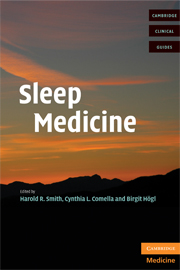Book contents
- Frontmatter
- Contents
- List of contributors
- Foreword
- SECTION 1 NORMAL SLEEP
- SECTION 2 SLEEP DISORDERS
- 3 Parasomnias
- 4 Circadian rhythm disorders
- 5 Excessive somnolence disorders
- 6 Insomnias
- 7 Restless legs syndrome and periodic limb movement disorder
- 8 Sleep apnea (central and obstructive)
- SECTION 3 SLEEP IN SPECIALTY AREAS
- Index
- References
3 - Parasomnias
from SECTION 2 - SLEEP DISORDERS
Published online by Cambridge University Press: 08 August 2009
- Frontmatter
- Contents
- List of contributors
- Foreword
- SECTION 1 NORMAL SLEEP
- SECTION 2 SLEEP DISORDERS
- 3 Parasomnias
- 4 Circadian rhythm disorders
- 5 Excessive somnolence disorders
- 6 Insomnias
- 7 Restless legs syndrome and periodic limb movement disorder
- 8 Sleep apnea (central and obstructive)
- SECTION 3 SLEEP IN SPECIALTY AREAS
- Index
- References
Summary
Introduction
Parasomnias, as described in the recent second edition of the International Classification of Sleep Disorders, are “undesirable physical events or experiences” occurring during sleep transition, during arousal from sleep, or within the sleep period. They correspond to CNS patterns of activation expressed through either muscle/motoric or autonomic functions. Therefore they may range from abnormal sleep-related movements to emotions, perceptions, dreaming, or behaviors. In the most complex forms even “basic drive state” may emerge, resulting in complex abnormal behaviors such as sleep-related eating disorder (SRED) or abnormal sexual behaviors.
The pathophysiology of the parasomnias does not rely on an altered sleep structure, and physiological sleep processes are not involved. Rather the concept that sleep and wakefulness are not invariably mutually exclusive states is the main pathophysiology underlying parasomnias. Yet they are included among clinical disorders due to the resulting injuries, and adverse health and psychosocial effects, which may affect the bed partner as well as the patient. The word parasomnia derives from the Greek para combined with the Latin somnus: events accompanying sleep. Parasomnias often involve automatic behavior, i.e., seemingly goal-directed, complex purposeful behaviors enacted without the conscious awareness and volition of the individual, who cannot exercise conscious deliberate control over his or her behaviors and sleep-related experiences.
- Type
- Chapter
- Information
- Sleep Medicine , pp. 47 - 55Publisher: Cambridge University PressPrint publication year: 2008



